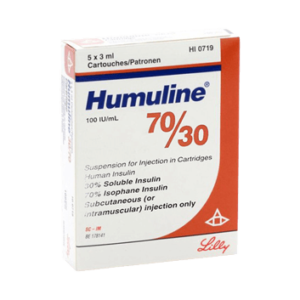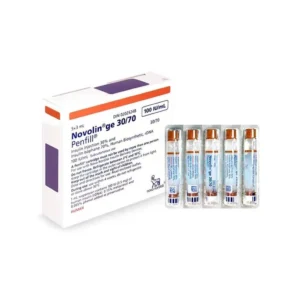No products in the cart.
Lantus Vials (100 UnitsmL)
$82.57 – $386.75
Lantus Vials provide a reliable solution for managing diabetes with long-acting insulin. Each vial contains insulin glargine, designed to deliver consistent blood sugar control for up to 24 hours. Perfect for once-daily dosing, Lantus helps minimize fluctuations in glucose levels, making it an essential part of effective diabetes management. Trust Lantus for stable, effective, and convenient insulin therapy tailored to your needs.
Lantus Vials: A Comprehensive Guide to Diabetes Management
Introduction to Lantus Vials
Lantus Vials (insulin glargine) play a vital role in the effective management of diabetes, specifically for individuals living with type 1 and type 2 diabetes. Lantus is a long-acting insulin formulation that provides a steady release of insulin over a 24-hour period, which is crucial for maintaining stable blood glucose levels. The convenience of once-daily dosing, combined with its reliable action profile, makes Lantus an essential part of many patients’ diabetes treatment plans.
Diabetes is a chronic condition that requires careful management to prevent complications such as cardiovascular disease, nerve damage, kidney failure, and vision problems. By using Lantus Vials, patients can achieve better glycemic control and improve their overall quality of life.
Understanding Insulin and Its Role in Diabetes
Insulin is a hormone produced by the pancreas that is essential for regulating blood sugar levels. It allows cells in the body to take in glucose from the bloodstream to use for energy or to store for later use. In individuals with diabetes, the body either does not produce enough insulin (type 1 diabetes) or cannot effectively use the insulin it produces (type 2 diabetes). This leads to elevated blood sugar levels, which can have serious health consequences over time.
Lantus Vials are designed to help those with diabetes by providing a long-acting form of insulin that mimics the natural basal insulin secretion of the pancreas. This helps to stabilize blood sugar levels throughout the day and night, allowing for a more balanced and healthy life.
Key Features of Lantus Vials
1. Long-Lasting Action: Lantus provides a consistent insulin release over 24 hours, helping to maintain stable blood sugar levels with fewer fluctuations. This is especially beneficial for patients who experience high or low blood sugar during the night.
2. Once-Daily Dosing: Unlike rapid-acting insulins that require multiple daily injections, Lantus is administered once a day, making it more convenient for patients to manage their diabetes. This simplification can lead to better adherence to treatment plans.
3. Flexibility: Lantus can be injected at any time of the day, as long as it is done at the same time every day. This allows patients to tailor their insulin regimen to fit their lifestyle and daily routine.
4. Reduced Risk of Hypoglycemia: The steady release of insulin provided by Lantus lowers the risk of hypoglycemic episodes, particularly during the night. Patients are less likely to experience sudden drops in blood sugar levels compared to short-acting insulins.
5. Compatibility with Other Insulins: Lantus can be used in combination with rapid-acting insulins for meal coverage. This versatility allows healthcare providers to create personalized treatment plans that meet the specific needs of their patients.
How Lantus Works
Lantus (insulin glargine) is a modified form of human insulin that is designed to provide a slow and steady release of insulin over a 24-hour period. Upon injection, Lantus forms micro precipitates in the subcutaneous tissue, which gradually dissolve to release insulin into the bloodstream. This mechanism results in a flat action profile, meaning that Lantus does not have a peak effect like some other insulins.
Pharmacokinetics of Lantus
The pharmacokinetics of Lantus indicates that it begins to lower blood glucose levels within 1 to 2 hours after injection. It reaches its maximum effect around 6 to 8 hours post-injection and continues to work for approximately 24 hours. This makes Lantus an ideal choice for providing basal insulin coverage throughout the day and night.
Indications for Use
Lantus Vials are indicated for the following:
• Type 1 Diabetes: For individuals who require exogenous insulin therapy due to their bodies’ inability to produce insulin. Lantus serves as the basal insulin needed to maintain normal blood glucose levels.
• Type 2 Diabetes: In patients whose diabetes cannot be managed adequately with oral medications alone, Lantus can be added to their treatment regimen to enhance glycemic control.
Importance of Individualized Treatment
Each patient’s needs are unique, and the effectiveness of Lantus therapy can depend on various factors, including diet, activity level, and overall health. Therefore, it is crucial for patients to work closely with their healthcare providers to develop a personalized treatment plan that considers their individual circumstances.
Benefits of Using Lantus Vials
1. Improved Glycemic Control: Regular use of Lantus can lead to better overall blood glucose management, resulting in lower HbA1c levels and a reduced risk of diabetes-related complications.
2. Convenience of Administration: With the simplicity of a once-daily injection, Lantus makes diabetes management easier, allowing patients to focus more on their daily lives and less on their treatment regimen.
3. Stability of Blood Sugar Levels: The predictable action of Lantus helps reduce the highs and lows associated with blood sugar levels, leading to more stable glucose readings throughout the day.
4. Enhanced Quality of Life: With fewer fluctuations in blood sugar levels, many patients experience improved energy levels and overall well-being, allowing them to engage in their preferred activities without constant worry about their diabetes management.
5. Reduced Anxiety Around Diabetes Management: The reliability of Lantus in providing steady insulin coverage can help reduce the stress and anxiety often associated with managing diabetes.
Administration of Lantus Vials
Lantus Vials are intended for subcutaneous injection. Here is a step-by-step guide to ensure proper administration:
Preparation Steps
1. Gather Supplies: You will need Lantus Vials, an insulin syringe or pen, alcohol swabs, and a sharps container for disposal.
2. Wash Hands: Always wash your hands thoroughly with soap and water before handling insulin to prevent contamination.
3. Inspect the Vial: Check the vial for clarity. Lantus should be clear and colorless. Do not use if it appears cloudy, discolored, or contains particles.
Injection Steps
1. Clean the Vial: Use an alcohol swab to clean the rubber stopper of the vial before inserting the needle.
2. Draw the Insulin: Using a syringe, insert the needle into the vial, invert it, and draw the prescribed amount of Lantus into the syringe. Ensure there are no air bubbles before proceeding.
3. Select Injection Site: Choose a suitable injection site, typically the abdomen or thigh. Rotate injection sites to prevent lipodystrophy, which can occur from repeated injections in the same area.
4. Administer the Injection: Pinch the skin to create a fold, insert the needle at a 90-degree angle, and inject the insulin slowly and steadily.
5. Dispose of Supplies: After the injection, dispose of the used needle and syringe in a sharps container. Ensure the vial is capped and stored properly.
Storage Instructions
• Unopened Vials: Store unopened Lantus Vials in the refrigerator between 36°F to 46°F (2°C to 8°C). Do not freeze.
• Opened Vials: Once opened, Lantus Vials can be kept at room temperature (up to 77°F or 25°C) for up to 28 days. Any unused insulin after this period should be disposed of safely.
Dosage and Administration Considerations
Determining the correct dosage of Lantus is critical for effective diabetes management. The dosage should be individualized based on the patient’s specific needs, blood glucose levels, and lifestyle factors.
Starting Dosage
• Type 1 Diabetes: The initial dose is typically based on the patient’s total daily insulin requirements, usually ranging from 0.5 to 1.0 units per kilogram of body weight.
• Type 2 Diabetes: Patients starting Lantus while on oral antidiabetic medications may begin with a starting dose of 10 to 20 units, depending on their prior insulin regimen and current blood glucose levels.
Adjustment of Dosage
Patients may require adjustments to their Lantus dosage based on several factors:
• Blood Glucose Monitoring: Regular monitoring of blood glucose levels is essential for assessing the effectiveness of Lantus and determining if dosage adjustments are necessary.
• Dietary Changes: Modifications in diet can impact insulin requirements. Patients should work with healthcare professionals to adjust their insulin based on their meal plans.
• Physical Activity: Increased physical activity can enhance insulin sensitivity and may require adjustments in insulin dosage to prevent hypoglycemia.
• Illness or Stress: Physical stress or illness can raise insulin requirements. Conversely, recovery from illness may decrease the need for insulin.
Important Considerations
• Do Not Mix Insulins: Lantus should not be mixed with other insulins in the same syringe, as this may alter its effectiveness.
• Gradual Adjustments: Any changes in dosage should be made gradually and under the supervision of a healthcare professional to avoid hypoglycemic episodes.
• Recognizing Hypoglycemia: Patients should be educated on the signs and symptoms of hypoglycemia (low blood sugar) and how to respond appropriately.
Potential Side Effects of Lantus
While Lantus is generally well tolerated, like all medications, it can cause side effects in some individuals. Common side effects include:
• Hypoglycemia: The most significant risk associated with insulin therapy. Symptoms may include shakiness, sweating, confusion, irritability, rapid heartbeat, and headache. It is vital to treat hypoglycemia promptly with fast-acting carbohydrates.
• Injection Site Reactions: Patients may experience redness, swelling, or itching at the injection site. Rotating injection sites can help minimize these reactions.
• Weight Gain: Some patients may notice weight gain while using Lantus, which can occur due to improved glucose control and increased caloric intake.
• Allergic Reactions: Rarely, some individuals may experience allergic reactions to insulin, including rash, swelling, or difficulty breathing. Patients should seek medical attention if they notice any severe allergic reactions.
Long-Term Considerations
Long-term use of Lantus may be associated with certain health considerations:
• Potential for Insulin Resistance: Over time, some patients may develop insulin resistance, requiring higher doses of insulin to achieve the desired blood glucose control.
• Lipoatrophy or Lipohypertrophy: Repeated injections in the same area may lead to localized changes in fat tissue, causing lumps or depressions. It is important to rotate injection sites regularly.
Conclusion
Lantus Vials provide a reliable and effective solution for managing diabetes, helping patients maintain stable blood sugar levels and improve their quality of life. With the convenience of once-daily administration and compatibility with other insulins, Lantus is a cornerstone in many diabetes treatment plans.
Patients are encouraged to work closely with their healthcare providers to ensure optimal use of Lantus and to tailor their diabetes management strategies to their individual needs. By doing so, they can achieve better glycemic control and lead healthier lives.
Incorporating Lantus into a comprehensive diabetes management plan—alongside regular monitoring, a balanced diet, and physical activity—can help individuals with diabetes navigate their condition with confidence and achieve their health goals.
Discover a wide range of diabetes solutions and products on our website! We’re dedicated to providing you with the best tools and resources to manage your health effectively. From innovative testing supplies to helpful educational materials, we have everything you need to stay on top of your diabetes care. Don’t miss out on the latest advancements and offers explore our selection today and find the perfect products to support your journey towards better health!
Additional information
| Lantus Vial - 100u/mL/10mL | 1 vial, 2 vials, 3 vials, 4 vials, 5 vials |
|---|











Reviews
There are no reviews yet.